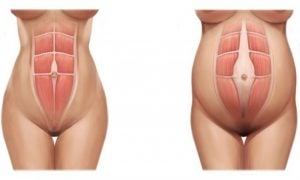 We take on a recently very popular subject, namely the abdominal muscle separation. Interestingly, this condition may affect both women after childbirth, people exercising abdominal muscles intensely, and people (more often men) with abdominal obesity, especially those who suffer from a smoker’s cough or having Chronic Obstructive Pulmonary Disease (COPD).
We take on a recently very popular subject, namely the abdominal muscle separation. Interestingly, this condition may affect both women after childbirth, people exercising abdominal muscles intensely, and people (more often men) with abdominal obesity, especially those who suffer from a smoker’s cough or having Chronic Obstructive Pulmonary Disease (COPD).
The abdominal muscle consists of two muscle strands connected by a fibrous structure called the white border. It is about 33 cm long and 10 mm wide, and adheres to the sternum and pubic symphysis. The separation of the rectus abdominis muscle is the broadening of the white line and thus the spread of two muscle strands.
During pregnancy, especially in the third trimester, this muscle can relax and expand due to two hormones – relexin and elastin, which act as a relaxant on the connective tissue. Among athletes, excessive overloading of abdominal muscles, abnormal exercise and increasing pressure in the abdomen through abnormal breathing during exercise can also lead to the separation of abdominal muscles.
How do you check if the abdominal muscles have separated?
First of all, you will recognise it by the appearance of your stomach, which resembles the stomach of a pregnant woman. The persons described above have a greater risk factor for this phenomenon. To see if this condition affects you lie on a flat, hard surface, bend your legs in your hips and knees so that your feet are on the ground, then lift your head and shoulders off the ground, like you want to do crunches and check your abdominal line with your fingers from the end of the sternum (hilt) to the pubic symphysis. If you feel that your fingers are sinking into the depths and you are squeezing your muscles from the side, turn your hand upside down and check how many fingers you can put on. One finger corresponds to 1 cm. The more fingers you can put on, the larger the separation.
If you recognise this condition, do not panic. The range itself, especially if it is small, is not dangerous. But you should not leave it that way, because if it does happen then the muscles will not come together. Appropriate exercises are needed. Do not do any exercises on your own, because you can harm yourself! Go to an experienced physiotherapist who will examine you closely and show you exercises that can close the separation.

